| Here is the motor associated with the resrictotor plate |
 |
Real Odd-Ball & NON-US Motors
USA Made Motors : Johnson and Evinrude had some odd motors, which usually were odd hp ratings, like 14hp, 28 hp, 33 hp etc. These sometimes were sold as commercial motors, or cheaper grade without electric starters, power tilt, or oil injection. One a 14 hp made in 1989, (VE14REC or VJ14REC) along with it's well known cousin the 15hp of the same year. The 14 used the current 15 hp powerhead, but the lower unit off the previous years 15hp. And it does not have a choke, but a fuel primer. Many times we also see some forms of this combo in other parts of the world, usually with an older carburetor.
Non USA Made Motors : Johnson and Evinrude made outboard motors for worldwide usage and had manufacturing/assembly plants in other parts of the world, Canada, Belgium, Australia and Hong Kong.
Many of these Johnson/Evinrude motors did not follow the year-on-year model changes as their American counterparts. So, if you are working on one of these, and have a Clymer or Seloc manual, read it with caution, but be prepared if a few things might be slightly different. Australian motors can also be included in this group. The suspicion here is that any left over motors at year end, got pushed to other countries. Also there are usually additional letters in the model plate ID. If it was a Canadian motor, there would have been a prefix letter "C" on the model number as in, CJ10RCDB. For more detailed information on worldwide production, CLICK HERE.
Also an ODD-BALL (to us US customers) did not have to be made in one of those non US plants, but could have a US ID tag, but logically made for usage in a non American location, but model number IDs do not exist. Here there seem to be no rules.
Here, on these motors, I would not be surprised to even see "experimental" modifications/alterations show up.
Different Model Designation : Sometimes odd-ball motors pop out of the woodwork. Here is an interesting bit of information, for a Johnson "GT10" which apparently is actually a "restricted" 15hp motor, but not a true 9.9hp as we know it here in the states. These are usually seen in Europe or Australia, however I have heard of one from Canada. Ones I am familiar with were actually an actual 15hp motor but with a restrictor plate between the carburetor and the intake manifold apparently to economically change the power to 10hp. These motors seem to be made using pre 93 OMC 9.9 or 15hp parts even if the motor was made later, kind of like a cleanup project into other parts of the world.
In doing internet an search, all I saw were the pre-93
motors, however having a model number with some dating the motors into 2006. This
being the case, I suspect that when the 93 models came out, the left over
parts were shipped to Belgium and assembled there under the GT10
designation. As in this search, I have seen the deep metallic gray
color on these GT10s that is conducive to 2000+ motors.
In my correspondence with these owners, the motors seem to
have been on the market under only the Johnson brand at least in 1988 and up
to 2006. Now they also tell me that in some countries (Germany for
one, as I have a boater friend there), normal
operation of a boat with over a specific HP, you need to take an extensive
test and be relieved of some weight in your wallet. It seems that depending
on the country this HP can be from 6 to 10hp. So maybe the motor
manufacturers are detuning existing motors to come in under that rating like
they did here in the US for the 9.9hp motor??
The restrictor in the photo below, came from model number BJ10SPCEC, which places it as a 1989. This one is from
Europe, made in Belgium, short shaft, electric start and with an AC lighting
outlet. Which is odd because usually the electric start motors did
not have the AC lighting provision.
I have seen another 1989, CE10SPCEC made in Peterborough,
Canada, shown below.
| Here is the motor associated with the resrictotor plate |
 |
I would think trying to troll with a motor modified in this manner may
not be ideal even though the carburetor would be adjusted downward to any
possible idle smoothness matching the air flow. But without knowing the
history behind these, we may never know. So if any reader has any more
information, please contact me so I can correct my suspicions or update this
info.
| Here is the restrictor plate mentioned for the two motors above. |
|
|
I have
also corresponded with a gentleman in Australia who has a 1979 15hp Evinrude
that should have electronic ignition (if it was here in the states). However it
has what appears to be original magneto ignition, which is 3 years after that
was changed over here in the states. It also sports the 1974 head.
His ID plate reads, Evinrude Motors, Bankstown, New South Wales, Australia. A
division of Outboard Marine Corporation Pty Ltd., Aus. Again, a chance to use up surplus
parts in other parts of the world. Talk about a non OMC repair man's nightmares
who does not have access to factory manuals in identifying parts, 20 or 30 years later.
Real Oddballs : You may also encounter motors that you can not identify. These may consist of a 9.9 or 15hp powerhead mounted on a older 10/15/18hp complete exhaust housing lower unit. Here the HP will not be
consistent with US models, being like a 9, 10 or 14hp. And the model number does not even show anywhere in the US factory lists. These appear to be a mix-match of left over parts that were assembled and or shipped to distant parts of the world. And initially one seemingly common denominator is that all I have seen or heard of are all Evinrudes, however a Johnson has now been uncovered. Some of these are common if made in Hong Kong, and model numbers do not coincide with any published information. About the only way to somewhat match things up is to carefully observe the motor UNDER the cowling. This would include rope starter version, flywheel, ignition, carburetor type, whether plastic topped or not, thermostat placement on the head, coils, upper cowling shape indicating pre or post 1986 to accommodate the top mounted thermostat, and throttle twist grip/kill button. These may all help to somewhat date the powerhead.
In the motor shown in the photos below, the name "Worktwin" is indicative of an Evinrude name used prior to 1975. The model number is 90903R which does not come up anywhere. My guess is that this marina in Australia acquired these misfits for a rental fleet.
The electronics are magneto style, the midsection appears to be from a 10hp QD or 15/18hp FD model made for a 5 bolt lower unit and the extension for the gearbox indicates it is a later 4 bolt gearbox. The color of the midsection is representative of Evinrudes from 1963 to1969. The powerhead was made starting in 1975, with the magneto being replaced in 1977 by electronic ignition. There appears to be some red plastic at the rope starter that does not seem normal for those years. The powerhead's lower pan appears to be modified to allow the throttle linkage to align with the earlier FD twist grip throttle linkage. The midsection is definitely off an earlier motor. The upper cowling is off a Johnson 1974 or later, or an Evinrude from1983 up to 1987.
But notice the excellent condition of the upper cowling, this motor just surfaced in 2014, so my guess is that this motor has been setting for a GOOD NUMBER of years.
| Upper Cowling | Here shows the mix-match of OMC parts & a long shaft extension |
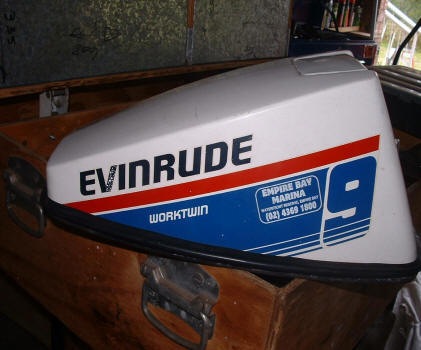 |
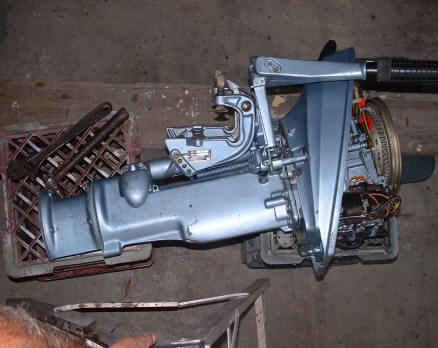 |
Here is another Evinrude model, VE14RCCS made in 1988 in Hong Kong, which
is very similar to the one shown above. This one was advertised for sale
in Minnesota, but has a lot of salt corrosion?
I notice there are no provisions for a choke on the carb but has a carb fuel
primer. Fuel connector on the RH side instead of LH of lower cowling.
Something else I noticed, is the powerhead is not rubber
mounted like it’s cousins. No rubber mount on the front extension of the
recoil starter base, NOR the RH side plate does not have one on it’s bottom
(meaning a different sideplate). Here the lower pan/cowling is simply held in
place between the powerhead and the midsection, like many smaller motors are.
The lower unit matches the midsection of the 5 bolt 15/18hp
model (some used a 4 bolt to a 5 bolt). The idle adjustment does not have a
knob, just a hole to use a screwdriver.. Looks like it uses the cable twist
throttle, so probably just the kill button on the twist grip end of the mid 87
on. I would guess the gearbox off the 18hp.
The few photos available does not show the clamping bracket
so no guess what it is off of.
| Side view, note fuel connector location | Here you see the salt corrosion, carb, missing starter, & no rubber motor mounts |
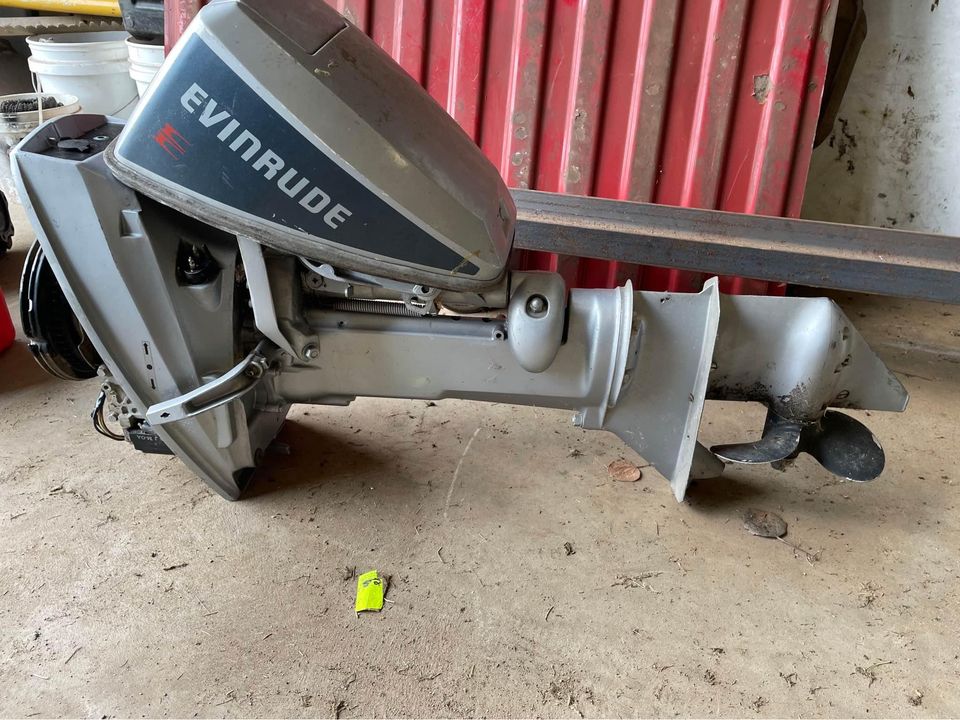 |
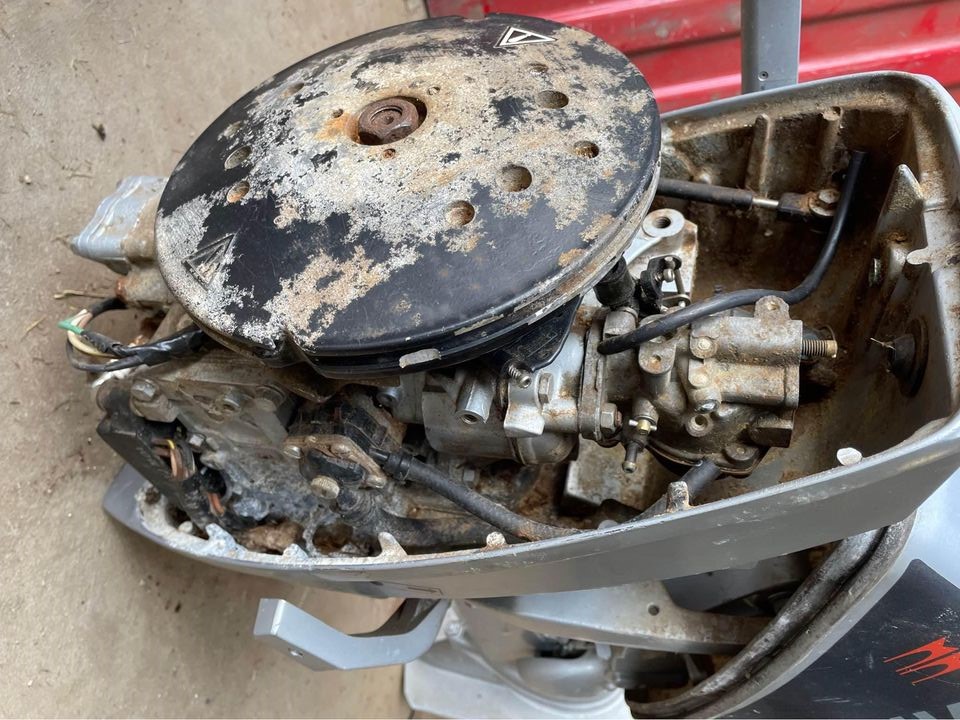 |
Another odd ball, but very similar shown above. I
have recently been contacted by a owner who has a Johnson J10RSM, which again does not
exist on most paper lists. He was told that it more than likely was a
commercial model??
It appears to be very close to the same
motor shown above, but made in USA. It has pretty much the same
powerhead as was common in 1983, and with the right color. But it
sports a midsection off a
old QD10 hp prior to 1958 which had
the larger 5 bolt unit which were the same as the FD15's and 18's had in
that same era. Then the lower unit is off a post 1958 QD or FD.
Now, take a look at the fins on the sides of the gearbox ???
| Here, you see a pretty clear 1983 upper unit | Here shows the mix-match of the 5 bolt med-section with the 4 bolt gear box |
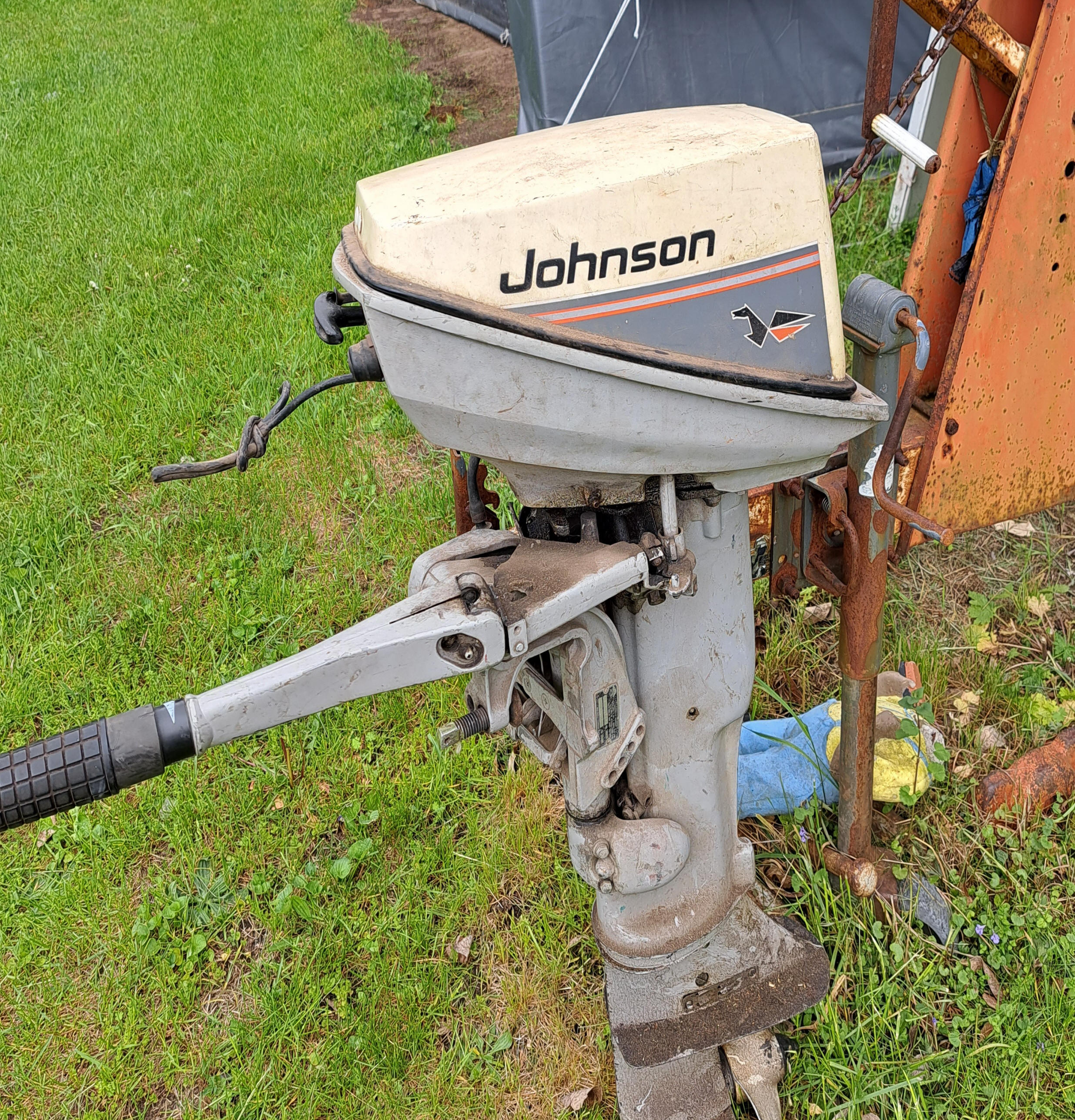 |
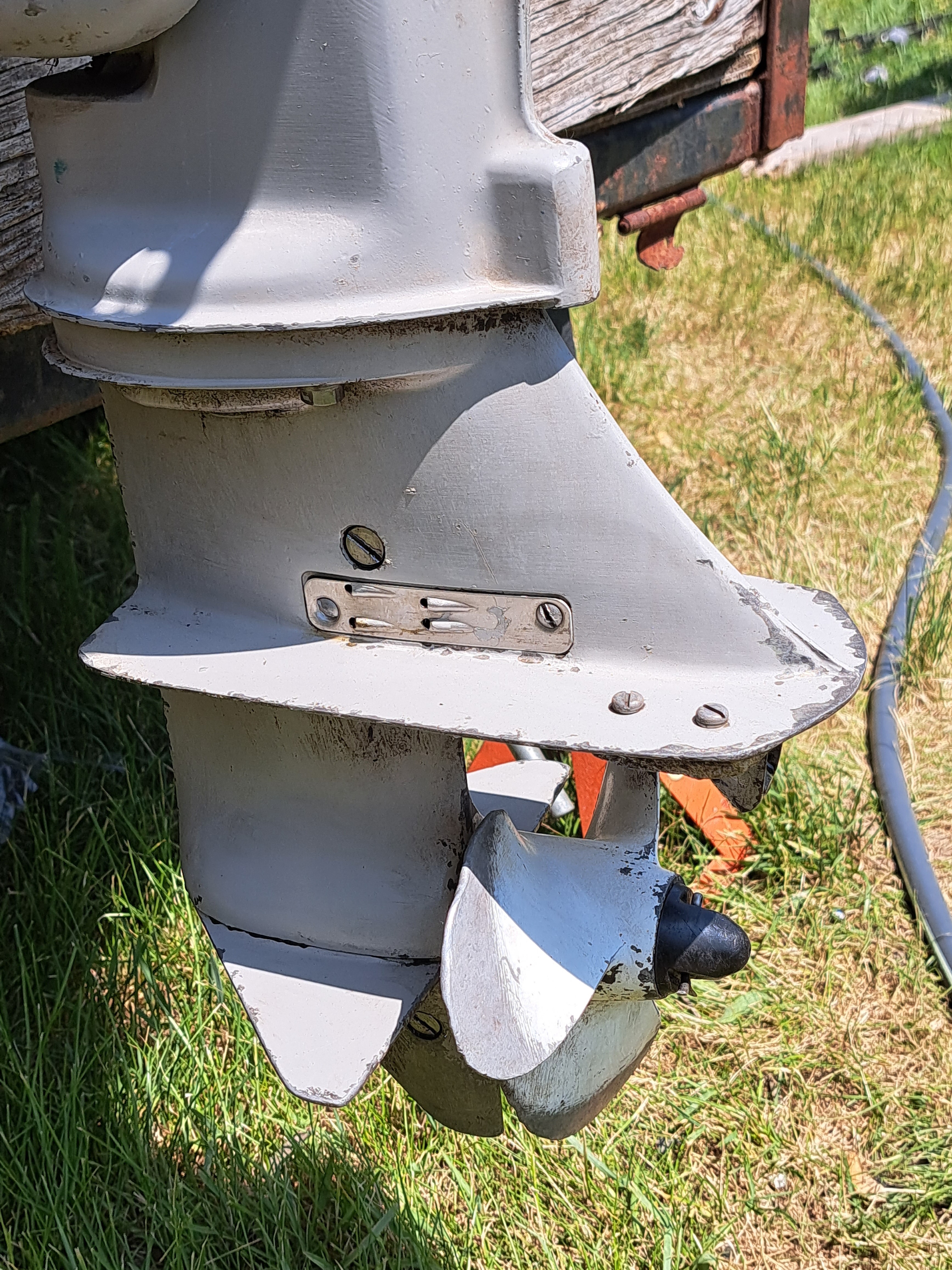 |
Another one I recently became aware of from Belgium was a 15hp 1991 Evinrude that has a pre 1987 metal topped carburetor.
| Here the Carb does not match any of the US made motors of that time frame |
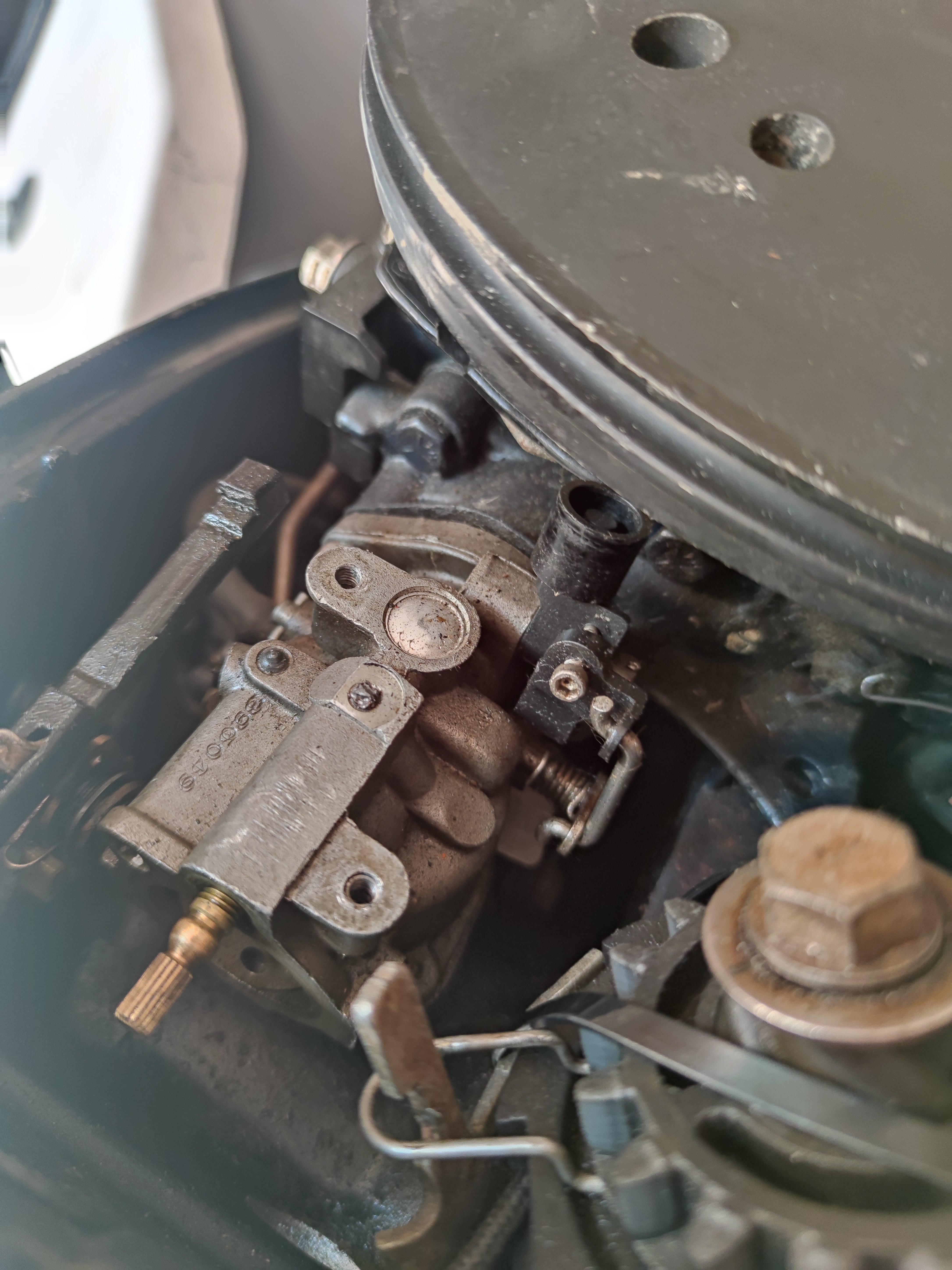 |
Commercial Motors : Many times readers here who were told their above type motor was a commercial, WELL, possibly not, but read on. I am making possible exceptions here. Anyone who can clarify, please contact me. Initially I thought all the gray painted lower sections were commercial motors, now I am not sure. I can verify that at least a 1983 9.9hp and a 1984 6hp recreational motors were painted those colors. So maybe somewhere along the line certain years and sizes of recreational Johnson motors were painted like this. You can tell if the gray is original if the instruction decals are in white (as seen above) instead of black lettering. This touchup paint is labeled "platinum gray" and listed for motors from 1984 to 1987.
There is mention in the Sierra and NAPA catalogs of "Commercial" 10 and 14 hp motors. According to the NAPA catalog, they were made from about 1988 to 1991. It appears these are cheaper units. They essentially are the same motor as the 9.9 or 15hp, but will have only a rope starter and with a tiller throttle handle system only. They used the older CD ignition system instead of the UFI as used on the regular motors at that same time. There was no provision for electric start or a charging system.
Some even use the older non thru the prop exhaust lower unit very similar to the older QD series. And the NAPA marine parts book verifies this by listing gearcase O-Rings for these as the same as the 1957-1963. My guess is that these were a sort of a "Clean Up" run made of older parts and sold thru some major discount stores, or for export out of the states.
Kerosene Powered :
You may even find some motors designed to run on Kerosene. Apparently they
were designed to be sold in underdeveloped countries where gasoline
was hard to obtain, but where Kerosene was used for heating oil. They usually have 2 headgaskets to lower the compression, used hotter spark plugs and possibly a small
internal gas tank for
starting, which was then switched over to kerosene after it is running. These
motors if shipped from the factories as a Kerosene motor would have had a
"K" as a prefix to the model number. An interesting thing here
is that Kerosene has a LONG shelf life, is less of a fire hazard, so it is
well accepted as propellant for sail boats that are at sea for extended periods
of time.
AC Output :
Some
of these motors (approximately 77-92?) could have been fitted with different stator
(electric start) assembly under the flywheel that gave a AC output voltage. We may not see
any here in the US, but about all the European and Asian motors seem to be equipped with this AC voltage
feature and is normally used for the running lights on the boat that the motor
does not have 12 volt electric start. The repair manuals say the regular output to the power
pack is 300 volts AC, for these motors, a converter is needed to make it charge a 12
volt battery. Without me having a owners manual, I am assuming that the
light bulbs would be 240 volt, which I understand is common in Europe.
This appears to a be a long way around to accomplish an effect, but then maybe we don't understand their ways either. These motors appear to have the electric start ignition under the flywheel and the junction block on the side of the motor for the wires, no rectifier converting the voltage to 12 volt, but for the rope start versions NO electric start flywheel .
The parts manual indicates that these stators were for motors with serial number prefixes of A, B, C, or E if used on an electric start model, while the prefix would have been H if on a rope starter version. This manual says "Serial Number prefix" however it would seem more in line with how things were done IF it was a prefix to the model number. There was a plug in outlet on the LH rear side of the upper lower cowling that had a rubber plug cap the covered the outlet.
In the two photos on the left below, the cream/red coils are for the AC lighting. In the center photo the ignition coil is the black one and the pickup timing module is the whitish unit on the far front side.
| Top view of magneto ignition & AC coils | Here is the newer CDI ignition & AC coils | Decal on top of cowling |
|
|
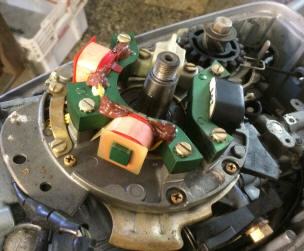 |
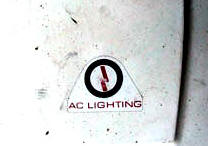 |
| Plug in on port side |
Another view of the plug in on port side |
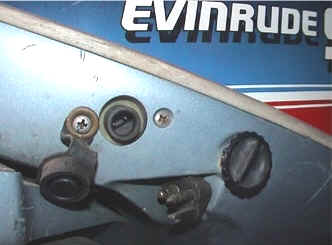 |
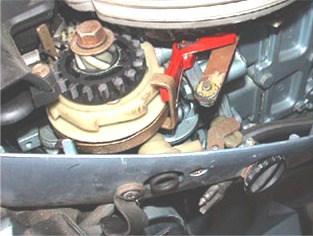 |
The above pictures were supplied by a gentleman from Germany who has an Evinrude E10BACNS motor that has AC lighting. From this I conclude to mean E = Evinrude 10 = HP B = Belgium A = AC Lighting, Rope Start CN = 1982 S = Model revision
Another motor, an Australian Evinrude, model AE15BAESR was referenced in an e-mail inquiry from gentleman there that had the same 3 wire plug coming out the side. His conclusion is as follows: A = Australia E = Evinrude 15 = HP BA = AC Lighting, Rope Start ES = 1990 R = Model revision.
Another model CJ10SPCEC on the ID plate, but the decal on the cowling says GT10. From how I would read this would be the C, meaning Canadian J = Johnson, 10 would be a 9.9 powerhead (however it and the 15hp shared the same block) the SP = could equate to Special, the CE = 1989 and the last C would be the model revision. And since there were a special run, would NOT have had an electric starter, but a rope starter.
Here is some info that I recently garnered off e-bay. "OMC, AC lighting kit #584864 kit, fits 1993-2000 9.9 & 15 hp 2 stroke engines. This kit provides the ability to power a boat's lighting system without a battery. Current is AC only and cannot be connected to a battery".
Copyright © 2023 LeeRoy Wisner All Rights Reserved
Back to the Ramblings
Home Page
Originally
stated 05-28-2023, Last Updated 10-17-2023
Contact the author
If you try t